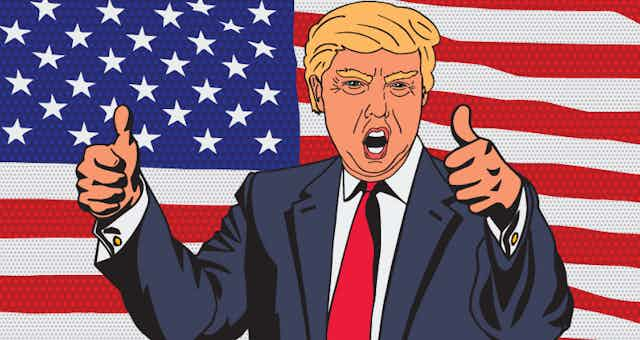In the run up to the 2016 presidential election, Donald Trump’s opponents could often be seen waving copies of the US Constitution, reminding him of the words of America’s founding fathers that, in their view, would constrain his excessive impulses.
These days it would not be surprising to see Trump taunting his opponents with the Constitution. Although some would argue it has curbed his worst excesses, this widely venerated document has actually enabled him. After all, it began by handing him the presidency.
Drafted in 1787 and ratified the following year, the US Constitution was supposed to provide an enhanced form of protection for citizens against any kind of governmental abuse. Entrenched as higher or “fundamental” law meant that ideals such as equality, democracy and a commitment to “we the people” were to take precedence. But as this mystical document aged and the American people became too polarised to update it, the flaws in their founding settlement have become more routinely exposed.
Because of America’s questionable electoral college system, which allocates each state a certain number of “electors” but whose weightings remain unequal, a candidate who lost by almost 3m votes became president. If anything, the 2016 election planted the seed for the way Trump has behaved throughout his presidency, as formal encounters with provisions in the US Constitution have ultimately tipped in his favour.
Trump’s victories
Although a few judicial rebukes suggest that the Constitution may be reining in Trump on some issues, such as the return of a CNN reporter’s press credentials and recent decisions against requirements for Medicaid (the government’s healthcare insurance programme), these are relatively minor victories, and there is little reason to think that the venerated Constitution is itself the decisive factor, as opposed to just federal statutory law.
In formal encounters on big ticket items, however, Trump has largely come out on top. The Muslim travel ban that many roundly mocked during the presidential campaign as unconstitutional was eventually deemed constitutional by the Supreme Court. President Trump didn’t need go to Congress to get this done, though if he’d tried to, nothing would have passed because of political opposition. And yet, because the robust American judiciary remains heavily involved in determining what is or isn’t constitutional, the ban ultimately passed.

The “advice and consent” of the Senate is another example of the American Constitution’s intricate separation of powers, as the Senate must approve all nominations for executive and judicial posts. The president has encountered little trouble under this clause because the Senate currently retains a Republican majority. Trump’s two most significant nominations, those for the US Supreme Court, eventually passed the vetting process, even though both confronted uniquely complex situations.
Neil Gorsuch’s nomination was only possible because, after the death of Justice Antonin Scalia, Republicans refused to even hold a hearing on Barack Obama’s nominee, Merrick Garland. The Constitution does not address how quickly hearings need to be held after nomination. Gorsuch comfortably passed his Senate vote.
Trump’s second and extremely controversial pick for the Supreme Court, Brett Kavanaugh, also passed through the proper constitutional hurdles before eventually being placed on the Court.
Recently, Republicans went “nuclear” to eliminate long-established rules on judicial and administrative nominations, changing the time for debate from 30 hours to two hours. This will allow a raft of Trump’s lower judicial appointments to proceed, and is yet another example of the Constitution’s “advice and consent” provision being manipulated into favouring the president.

The real push back
Where Trump has met resistance has largely been outside of the provisions of the Constitution. Mechanisms associated with political institutions have been the most effective. For example, the Constitution says nothing about the use of filibusters – an attempt to block or delay Senate action on an issue or bill. This rule states that 60 votes are needed in the Senate before debate can be closed on a matter.
President Trump was unable to fulfil his border wall promise during his first two years in office primarily because he could not get any funding measure through Congress. At one point he even suggested completely doing away with Senate filibusters, but the fact is there was little appetite for his border wall among his own party.
Eventually, when Trump got so frustrated with the normal political channels over his wall that he declared a national emergency, both the House of Representatives and the Senate passed resolutions condemning this action. In fact, the National Emergencies Act 1976 initially put Congressional restraints on any presidential emergency declaration, but the US Supreme Court did away with these in a 1983 judgment. This presents another example of powerful US courts determining what is or isn’t constitutional, ultimately handing the president more power while decreasing Congressional power.
The Constitution also fails to mention government shutdowns or the appointment of special counsel. The longest-ever US government shutdown – 35 days – came near the end of Trump’s first two years in the job, and was ultimately viewed as a significant loss for him.
Robert Mueller’s investigation into Russian interference in the presidential election has produced convictions for many of those associated with president Trump, including his personal “fixer” attorney Michael Cohen and his former presidential campaign chairman, Paul Manafort.
The redacted Mueller Report was released in early May, providing an abundance of new headaches for the administration. But given his previous (positive) encounters with the Constitution, president Trump now appears to be daring the Democrats to impeach him.
Statutory law has also played an important part in restraining the president. As Atlantic journalist David Graham recently pointed out, the reluctance of the president’s advisers to break federal law is one of the most significant constraints on the Trump administration.
Any form of enhanced protection for America and its citizens by the US Constitution has been overblown. Neither its legals mechanisms, nor those of the Supreme Court have managed to keep Donald Trump in check – that has fallen to politics, political institutions and the presence of federal law.

